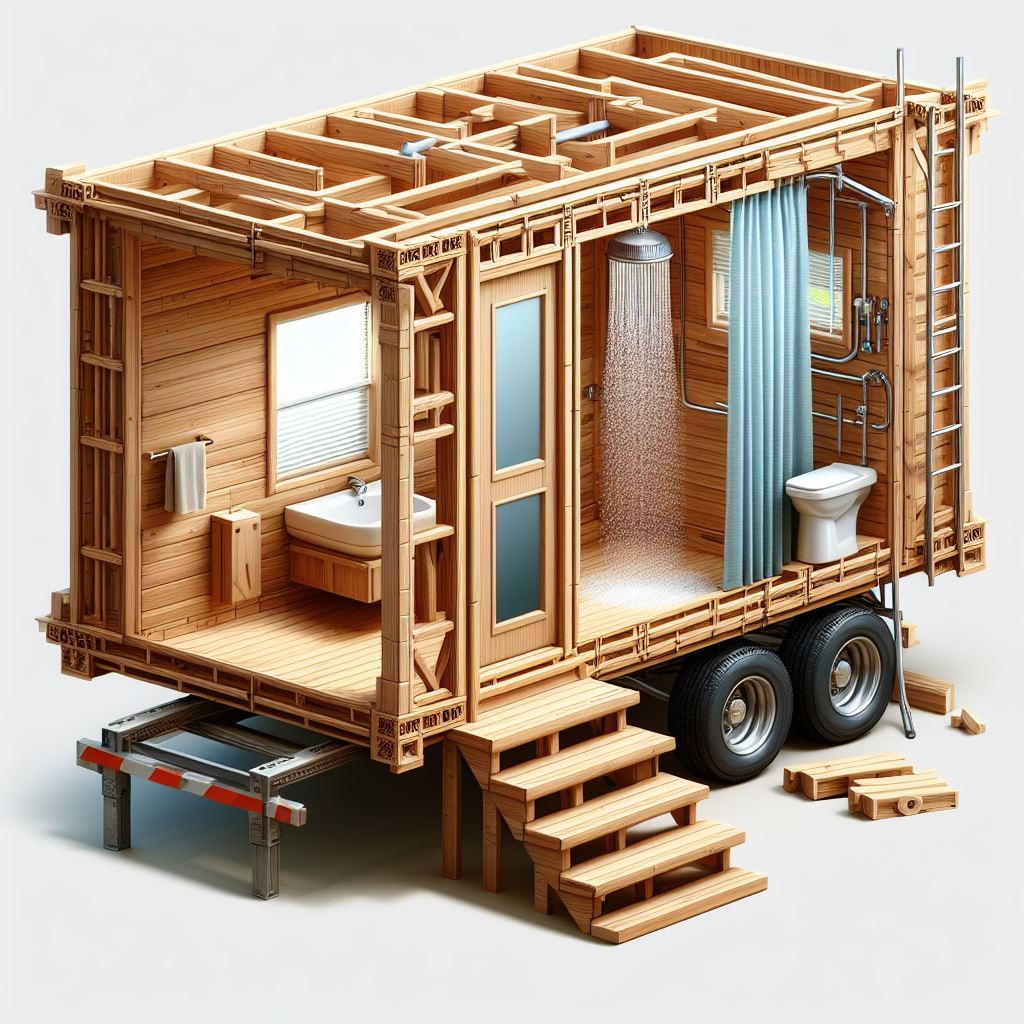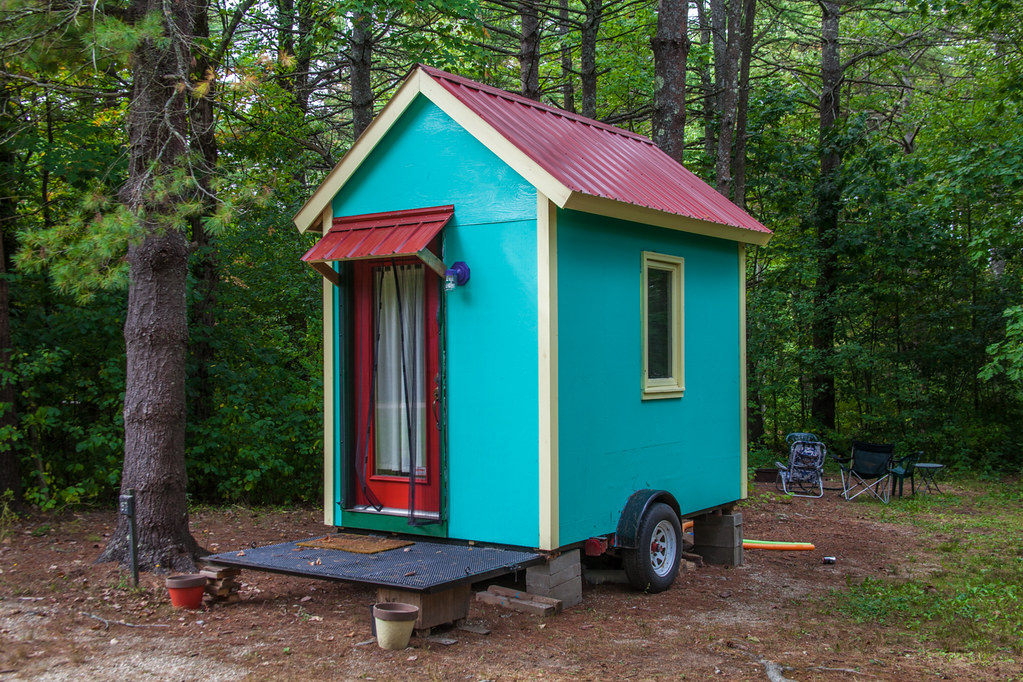
Tiny house composting toilets are all about optimizing space and maintaining sustainability for your home.
Composting toilets offer a practical and eco-friendly solution that aligns perfectly with these goals.
They not only help conserve water and reduce waste but also fit seamlessly into the compact and efficient design of your tiny or modular home.
In this buyer’s guide, we’ll walk you through the essentials of composting toilets for tiny house living.
We’ll start by explaining how these toilets work, and then explain the different types you can consider. Lastly, we’ll cover the maintenance of compost toilets.
How Do Composting Toilets Work?
Composting toilets use a natural process to decompose human waste into nutrient-rich compost, minimizing water usage and reducing environmental impact.
How It Works:

At the heart of a composting toilet is a process that converts waste into compost through aerobic decomposition. Here’s a simplified breakdown:
- Separation: Many composting toilets have a design that separates urine from solid waste. This separation helps in controlling odor and optimizing the composting process.
- Decomposition: Solid waste is combined with a bulking agent, like sawdust or coconut coir, which helps create the right conditions for decomposition. The waste and bulking agent mix in a chamber where microorganisms break down the materials into compost.
- Aeration: Adequate aeration is crucial. Composting toilets typically include a ventilation system that ensures airflow to speed up decomposition and control odors.
- Collection: The finished compost is collected in a lower chamber or drawer, where it can be removed periodically. The composting process generally takes several months to a year, depending on factors like temperature and moisture levels.
How Much Do Composting Toilets Cost?

While tiny living is all about affordability and minimalism, you should still spend the right amount of money on your ideal toilet setup.
Low end basic composting toilets can be as cheap as $100-$200 USD. This will typically be basic, dry composting system. These will mostly be made of plastic.
Medium-end composting toilets will cost about $500 USD. These are toilets that have adjustable pieces and multiple sections or use fans for aeration.
The highest-end composting toilets can easily cost over $1000. These will be toilets that have electric mechanisms for mixing compost with waste. They’ll also be made of higher quality materials such as wood or porcelain.
Why Composting Toilets Are The Best Choice for Your Tiny Home
For tiny house owners, maximizing space and efficiency is essential. Composting toilets offer several benefits that make them particularly suited for small living environments. Here’s why they’re a great choice:

- Space Efficiency: Composting toilets are compact and designed to fit in tight spaces. Unlike traditional toilets that require bulky plumbing and a large footprint, composting toilets can be installed in small, designated areas.
- Water Conservation: Off-grid often operate with limited water resources. Tiny house composting toilets use minimal to no water, which helps conserve valuable water resources. This is especially beneficial for tiny homes with off-grid water supplies.
- Reduced Waste Management: Composting toilets handle waste in a way that reduces the need for frequent maintenance. The composting process turns waste into nutrient-rich compost, which means less frequent trips to waste disposal sites.
- Sustainability: Composting toilets align with the eco-friendly ethos of tiny house living! They minimize environmental impact by reducing water usage and recycling human waste into compost that can be used to enrich soil.
- Less Plumbing Complexity: Installing a composting toilet eliminates the need for complex plumbing systems. This reduces both cost and labor. Plus, it’s great for off-grid tiny homes.
In summary, composting toilets provide a space-efficient, water-conserving, and sustainable option for tiny house living. They help you make the most of your limited space while supporting an eco-friendly lifestyle.
What’s The Best Type of Tiny House Composting Toilet?
Each type of composting toilet has its own features and benefits. It all depends on the setup of your tiny home, whether you are off grid, have extra space on your property, or have a small bathroom.
And of course, the most important factor is optimizing for reducing odor. This will also impact which toilet type you want.
Here’s a rundown of the main types:

Self-Contained Composting Toilets
These units combine the toilet and composting chamber into a single compact unit. They are easy to install and maintain, making them a popular choice for tiny homes.
Self-contained toilets typically include a ventilation system to control odors and promote decomposition. They are ideal for spaces where a separate composting chamber isn’t feasible.
You can find this type of toilet at NaturesHead.com (not affiliated)
Remote Composting Toilets

In these systems, the toilet and composting chamber are separate. The toilet is connected to a composting unit that can be installed in a different location, such as a basement or outdoor shed.
This setup can be beneficial for larger tiny homes or situations where the composting process needs to be isolated from the living area.
Shop this type of toilet at usa.sun-mar.com (not affiliated)
Dry Composting Toilets
These are one of the most popular types of composting toilets for mobile and tiny homes.

These toilets use minimal or no water, relying on dry composting methods to decompose waste. They are often simpler in design and require regular addition of bulking agents like sawdust or peat moss.
Dry composting toilets are well-suited for off-grid living and areas with limited water supply!
You can find this type of toilet at usa.sun-mar.com (not affiliated)
Aerobic Composting Toilets
Aerobic composting toilets are similar to dry composting, but they also use airflow to enhance the decomposition process. They often include a ventilation fan that helps circulate air and speed up composting.
These toilets are effective in controlling odors and ensuring efficient composting, making them a good option for tiny homes with good ventilation.
Learn more about this type of toilet from Trelino.com (not affiliated)
Batch Composting Toilets

Batch composting toilets have separate chambers for waste collection and composting. Once one chamber is full, the system is switched to the other chamber while the first one continues to compost.
This allows for continuous operation and efficient waste management. Batch systems are suitable for tiny homes where waste needs to be processed in a systematic manner.
Shop for this type of toilet from waterlesstoiletshop.com (not affiliated)
How To Maintain a Composting Toilet

Choosing the right composting toilet for your tiny home is just the beginning.
Proper setup, usage, and maintenance are crucial for ensuring it functions effectively and remains odor-free. Here’s a guide to help you manage your composting toilet:
Toilet and Bathroom Setup
- Location: Choose a location that’s convenient and accessible.
- For self-contained models, ensure the toilet is positioned on a level surface and near a ventilation source if required.
- For remote systems, place the composting chamber where it can be easily accessed and where ventilation can be maintained.
- Installation: Many composting toilets come with detailed installation guides. Ensure all connections are secure and that the ventilation system is properly installed to avoid odor issues.
- Ventilation: Proper ventilation is essential for effective composting. Make sure the ventilation fan is installed correctly and that air flow is unobstructed. This is crucial for controlling odors and speeding up the composting process.
Daily Maintenance of Your Toilet
- Daily Operation: For optimal performance, use the toilet as directed by the manufacturer. If using a dry composting model, add a bulking agent like sawdust or coconut coir with each use.
- Separation of Waste: If your composting toilet separates urine from solid waste, make sure to use it correctly to ensure effective composting and odor control. Follow guidelines for maintaining the separate compartments.
- Monitoring: Regularly check the composting chamber to ensure that the waste is decomposing properly. Look for signs of imbalance, such as excessive moisture or odor, and adjust the composting conditions as needed.
Long Term Maintenance
- Emptying: Composting toilets require periodic emptying of the compost chamber. The frequency depends on the size of the toilet and usage. Follow the manufacturer’s recommendations.
- Cleaning: Clean the toilet and its components regularly to maintain hygiene. Use non-toxic cleaners and avoid harsh chemicals that can disrupt the composting process.
- Inspecting: Regularly inspect the ventilation system, seals, and any connections to ensure they are functioning correctly. Address any issues promptly to prevent odors and ensure efficient composting.
Conclusion
Composting toilets are an excellent choice for tiny home owners seeking sustainability and efficiency in their waste management system.
By understanding how these toilets work, exploring the different types available, and mastering proper setup, usage, and maintenance, you can ensure a smooth and eco-friendly experience.
Investing in the right composting toilet not only enhances your tiny home’s functionality but also supports a greener lifestyle.
With the insights from this guide, you’re well-equipped to choose and maintain the best composting toilet for your needs, making your tiny home both comfortable and environmentally responsible.
Back to TinyRoam.com Home!



